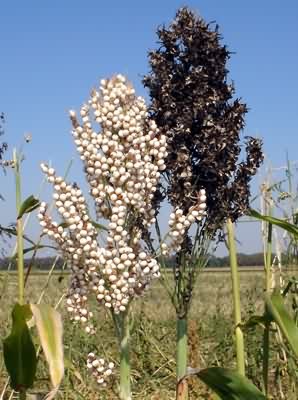Diseases
Sphacelotheca cruenta (Kuhn) Potter . Loose Smut of Sorghum
Systematic position.
Kingdom Fungi, division Basidiomycota, class Basidiomycetes, order Ustilaginales, family Ustilaginaceae, genus Sphacelotheca.Synonyms.
Ustilago cruenta Kuhn.Biological group.
Heterotroph.Morphology and biology.
The Loose Smut of Sorghum is caused by the fungus Sphacelotheca cruenta which forms teliospores (hibernating stage of the pathogen) and sporidia in its life cycle. Spherical or ellipsoidal, tinted, smooth teliospores are 4.8 x 10.8 mkm, rarely to 12 mkm in diameter. At sprouting they give a four-celled basidium with laterally and apically growing sporidia. The sporidia are spindle-shaped or oblong, 2.8 x 12.7 mkm in size. Mycelium is multicellular. The disease external symptoms become apparent immediately after panicle emergence from flag leaf sheath. All ovaries of inflorescences are affected, and smut sori can develop on peduncles, glumes, stamens as well. Their size can reach 1.5-2.0 cm in length and 0.4-0.5 cm in width. After rupture of sorus coat, fungal teliospores disperse, leaving clearly visible central column (columella). A panicle spangled with a lot of teliospores looks like a burnt fire-brand, sharply contrasting with healthy plants. The infection takes its origin from infected seeds. The infection occurs during only seedling stage of plant development.Distribution.
The Loose Smut of Sorghum was for the first time recorded in Russia in 1917. Within the area of sorghum growing in the former USSR territories, the disease is recorded in states of Central Asia and Transcaucasia, in Ukraine and Moldova.Ecology.
The Fungus Sph. cruenta is capable to develop at temperatures 10 to 32.C. The soil temperature 18-23.C and soil humidity 15-20% are optimal for mass infection of plants during seed germination.Economic significance.
The pathogen affects plant growth and development adversely. Grain yield losses correlate well with percentage of the disease distribution in fields. Control measures include cultivation of resistant varieties and hybrids, seed treatments before sowing.Reference citations:
Doshimov U.D. 1982. Sorghum smut fungi. Tashkent: Fan, 68 p. (in Russian).Gutner L.S. 1941. Smut fungi. Moscow, 383 p. (in Russian).
Silaev A.I. 2005. Biological and toxicological substantiation of adaptive protection of sorghum from smut diseases in the Volga Region. PhD Thesis. St.Petersburg: VIZR, 47 p. (in Russian).
Zaprometov N.G. 1917. List of cultivated plants in Turkestan, recorded from 1912 to 1916. Tashkent, 21 p. (in Russian).


